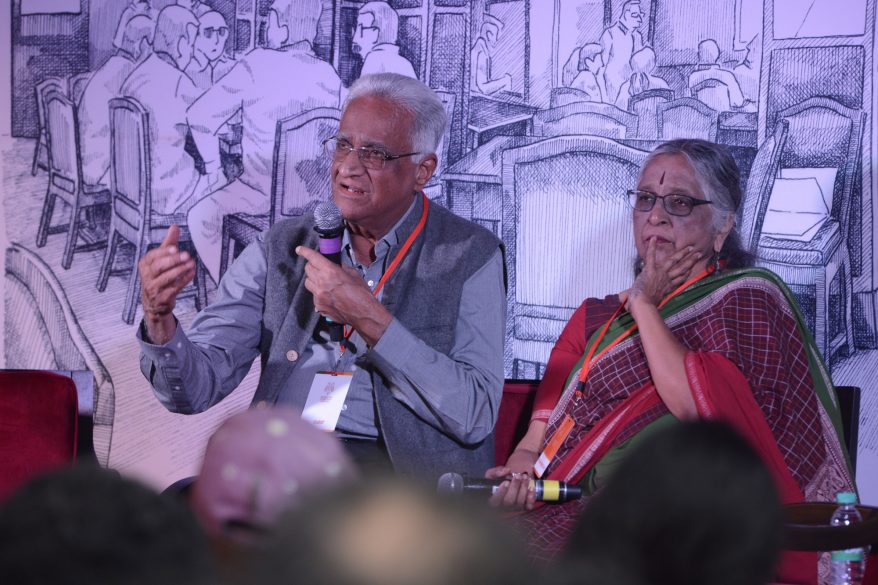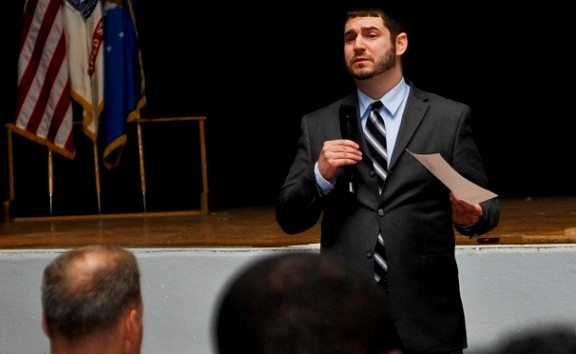A month from the abrogation of Article 370 by the Indian state, and the beginning of an unprecedented clampdown on communications from the valley, it would not be very remiss to say that Khursheed Ahmad’s installation and subsequent performance at the Dharti Arts Residency Open Studio was timely, even if somberly so. The last month has seen an uproar across certain sections of civil society around the abrogation of Article 370, the associated influx of security troops, the ban on communications, and widespread uncertainty, silence, and curfews. Reports of children being detained, some as young as eleven years old, have begun to filter through to Delhi, vehemently denied by most Indian media outlets as well as the state. All of this outrage, however, seems to be informed by a collective amnesia. Protests, outbreaks of violence, or reports of detainment and torture from Jammu and Kashmir are nothing new, however: the valley has been the setting for a bitter battle over many nationalisms and political positions for years now, even prior to the independence of the Indian state in 1947. It is this banal everydayness of violence that comes to the fore in Khursheed Ahmad’s installation as part of the Dharti Arts Residency. Questions of what it means to occupy this space, and derive meaning, belonging and desire from it haunt the viewer long after they leave the exhibition space.
Hosted by the Serendipity Arts Foundation, the Dharti Arts Residency is an intensive studio based residency for emerging artists. Over a period of three months, the four selected artists participate in various activities like peer conversations, critique sessions, gallery and studio visits, and artist talks. Alongside these activities, they are also expected to conceptualize and produce a new work, and the residency in 2019 drew to a close with a two-week open studio with installations by each of the artists. This year, the residency featured four artists from diverse backgrounds- Dharmendra Prasad, Farah Mulla, Shazia Salam, and Khursheed Ahmad.
Walking into C-340 at the Serendipity Arts Foundation during the open studio, I was first met by a number of people milling about upstairs. The installations were on a different floor, accessible by stairs. Quite helpfully, the organizers had set up a stand with brochures for the attendees: containing details of the artists, their current work, the Foundation, the residency, and even a floor plan pointing out where each artist’s installation was placed across the two rooms, halls, and an outside space.
Ahmad’s work spanned the whole of Hall 1, a multi-media installation that included photographs, a performance video, found objects, and near-sculptural blocks of shapes evocative of dargahs and mosques. A slight elevation afforded a view into the four-sided structure painted black by the artist. The structure was marked by openings all along its sides, and offered viewers a look inside, evoking the manner in which circumambulation around a dargah affords a glimpse of the inside. Each opening was covered by white paper, ripped to allow a limited view of the space inside, which contained a screen playing a video performance by the artist. The photographs around the installation, of various spaces across Kashmir, were marked by a spillage of yellow light filtering into the mundanity of the photographs, transforming them into objects that required greater contemplation and attention. The whole installation, however, came to life not on the first day of the open studio, but on the 20th of August, when Khursheed Ahmed performed a small, open-ended piece around his installation.
Ahmad hails from a family which practises the Kashmiri folk theatre form, Bhand Pather, which has a long history in the valley. With his interests across various practices, Ahmed brought into his performance elements of Bhand Pather. With no given script, the form usually depends on the performer’s improvisations. A protean form, Bhand Pather takes on various meanings in different public spaces at different times. In his short piece, this improvisational element of Pather shone through prominently, as Ahmed drew everyone into the room into his performance, into an act of creation itself. The art form in Kashmir has gained prominence, according to most commentators and practitioners, as a tool to spread information, awareness, and amusement, and this purported idea drove the tone of the whole performance.
Commenting on media representation of Kashmir and its conflict, Ahmad’s work has various elements that quietly, but significantly, shed light on the problems of media representation faced by any in or from the Valley. To me, the limited glimpse offered into the space, the fragmentary nature of the video performance that one could view from outside the box indicated poetically the nature of how information that travels to mainland India from the war-torn valley is nearly always in fragments, and often as unconfirmed rumours that one chooses not to believe. Ahmed’s use of performance, text, found object, sound, drawing, and photography, and his intentional overlapping of these media enhanced this point further- as the brochure declares, it not only challenges the interaction between the body and space, but also probingly questions the position of the viewer as a passive consumer of the event.
Beginning with a short reading of a poem, concentrating on the colour and metaphor of ‘yellow’, Ahmad started speaking. His quiet, stammering voice pervaded the room, and stammering seemed to be the common thread running through the performance. Like the occasional glimpses of the video, his hesitant voice drew him and his work together, verbalizing literally the irregularities and ruptures in the history of his place of belonging. As he spoke, he passed on the microphone, and his voice was taken up by others, with each person in the room picking up a refrain from the last, and modifying it in tone and content. The people in the room responded to it in different ways, gravely, or lightly, and some entered fully into the play of the performance itself, threading in words and references Ahmad himself did not touch upon: words like ‘Kashmir’, ‘blood’, and ‘Article 370’.
As he spoke, and others did, some shared in the performance by donning a ‘costume’- angarakhas of three colours, red, green, and black- that he handed out. The binary between viewers and performers fell away as they traced the contours of the room together, and through their movement, seemed to highlight the various elements of the installations. The photographs, for instance, in light of Ahmad’s poem, gain significance, with yellow light pervading them, belying their mundanity and their grim quality in some. A double-edged sword, like the shehnai Ahmad tried to play, and which, coincidentally, refused to sound a single note throughout, they left the audience questioning, inviting them to look closer, and perhaps even conveying that the frustration of being unable to fully grasp the content of the photograph is the space of a more productive examination. Not a violent protest, or even a very loud one, the performance thus became a process of understanding- a facilitation of conversation, and discussion around topics one chooses, in the Indian nation-state, not to look at.
Communication, or its lack, became another trope woven throughout the performance, thus. In one section, Khursheed Ahmad handed out letters, evoking the by now popular representation of Kashmir as a ‘country without a post office’. It is interesting to note that post the abrogation of Article 370, and the international coverage of the communications clampdown that has come with it, this is a trope repeatedly springing forth in conversations, performances, screenings, and debates around Kashmir. Somewhat hopeful in this context, however, is the idea of ‘witnessing’ Ahmad brings up. What does it mean to witness an event on media? What does it mean to ‘see’ or hear what is happening in Kashmir? As one of the attendees at the performance mentioned, the word shaahid (witness) in Urdu is closely related to shaheed (martyr), an intertwining of concepts that only hints at the myriad ways one can begin to understand what it means to witness, bodily, and often, fatally.
As individuals outside Kashmir, what elements do we associate Kashmir with? Images like a dove, barbed wire, water, the Jhelum, the distinctive smell of rose petals, agarbattis, shehnais, conflict, pellets, come to mind, and all of these were used by Ahmed throughout his performance. As almost disconnected elements, they came together to pose a crucial question about Kashmir, representation, and the Kashmiri voice struggling to find forms of self-representation. As is obvious to anyone looking into the present situation in the valley, Kashmiris occupy a number of different political positions. Perhaps Ahmad’s performance reaches its efficacy precisely in this: it leaves the performance open for interpretation, by anyone. For the viewer in Delhi, it poses the question not only of where the artist stands, but ultimately, where do you stand? Finally, then, it leaves the viewer with a set of uncertainties, and ruptures any smooth narratives that one could attach to a space of conflict, setting in motion an exploration the viewer can undertake with the artist himself.
Image Courtesy – Serendipity Arts Foundation and The Lumiere Project
About the Author: Madhubanti De has just completed her Masters from the School of Arts and Aesthetics, JNU. When she is not swamped with work, you can find her snuggled up with a cup of coffee and her newest favourite book for hours.











